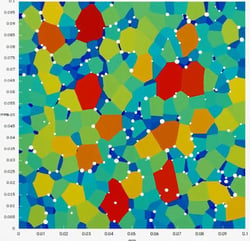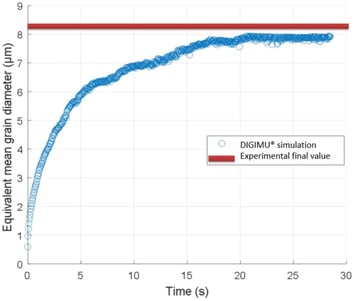DIGIMU® predicts microstructural evolutions occurring during thermomechanical processes and heat treatments of metallic alloys using physically based leading-edge models.
What is the Zener Pinning Phenomenon?
Zener pinning is the effect of the dispersion of fine second-phase particles (oxides or precipitates) onto the movement of grain boundaries through a polycrystal. For many manufacturing industries, especially in the aeronautical sector, control of the Zener pinning phenomenon is crucial as it may impact recovery, recrystallization and grain growth. Therefore, modeling Zener pinning is of help to alloy designers and engineers seeking to control grain size and consequently the part’s final properties.
How can DIGIMU® help?
 Particle pinning is often modeled by estimating an equivalent pinning pressure, or drag parameter that counteracts the other driving forces, capillarity and strain-induced boundary migration.
Particle pinning is often modeled by estimating an equivalent pinning pressure, or drag parameter that counteracts the other driving forces, capillarity and strain-induced boundary migration.
However, DIGIMU® models it directly by inserting the real second-phase particle population into the polycrystal and using only the capillarity effect of the standard boundary migration model. No additional parameters are needed, and the model is closer to reality. The evolution of the grains will not only be valid at the end of the process (steady-state final grain size), but also during the transient phase at the beginning of the heat treatment.
Special points for alloy designers: multiscale modelling and numerical experimentation
With DIGIMU®, you can easily generate polycrystals with different second-phase particle distributions (radii, fractions) and perform numerical experiments to predict the final grain size. Replacing most of the Design Of Experiments (DOE) by numerical simulation will drastically increase your study’s ‘Accuracy vs Cost’ ratio.
You can then easily deduce phenomenological mean field models and feed them with parameters perfectly adapted to your alloy. These mean field models can be further used to optimize alloy properties and the way they are process.
Example: Heat treatment of oxide dispersion-strengthened steel
- Ferritic steel + Y2Ti2O7 nanoparticles (oxides)
- Initial rolled structure (elongated aspect ratio and hardened grains)
- Non-uniform particle size distribution
Results analysis
- Precise grain boundary description thanks to level-set methods coupled with fully automated adaptive anisotropic remeshing
- The second-phase particle effect is only due to their geometry, no drag parameter has been added
- Very good agreement between simulation and experimental results
Control of grain size during heat treatment of an oxide-dispersion strengthened steel, after deformation. (F. Villaret, B. Hary, Y. de Carlan, T. Baudin, R. Logé, M. Bernacki)
Evolution of equivalent mean grain diameter

Very accurate prediction of the mean grain diameter at the end of the heat treatment
Key features of DIGIMU®
- Accurate prediction of the Zener Pinning effect on grain boundary migration, both for the transient phase and final grain size
- No need to use any additional drag parameters, just describe the second-phase particle population
- Using numerical experiments drastically increases the DOE’s accuracy/cost ratio
- Perfectly adapted for the optimization of alloy designs and heat treatment processes




